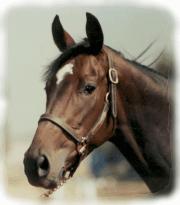A Horse, of Course with Don Blazer |
If you enjoy learning about horses, then you'll love our online courses. Each month you'll find a new column on our web site. We hope you'll enjoy it, and maybe e-mail us with questions or suggestions for other columns. A Horse, Of Course is a monthly column syndicated by Success Is Easy. If you like the column, call your local newspaper, or local horse publication and ask them to subscribe by contacting Success Is Easy. |
Horse Breeds Don Blazer copyright©2010 So youíve got a large, solid-hoofed quadruped domesticated since prehistoric times and employed as a beast of burden, or for carrying a rider. Youíve got an Equus caballus. Youíve got one of those things for which there are no fewer than 132 registries in the United States. Youíve got companionship, hardship, joy, frustration, relaxation, hard work, an investment and bills and a lot of arguments as to what youíve got. Youíve got a horseÖIím pretty sure of that. Iím also pretty sure Iím being politically incorrect to say itís pretty hard to tell what kind of horse youíve got. First, virtually all of the 132 breed associations claim their horse is the ďmost versatile horse in the world.Ē Does that mean the horses of all breed associations are horses with no single outstanding quality? Second, you canít often go by conformation standards as defined by the associations because, for the most part, they are all worded the same. (Does that mean a good horse is a good horse and essentially there arenít many conformational differences between one good horse and another good horse?) Third, thereís not much ďpurity of bloodĒ when you consider there are no fewer than 35 associations for part-blood or breed by performance or breed by color. There is the American Indian Horse Registry. Thatís logical. But I donít know what an American Indian Horse is, since the American Indians didnít have horses until the Spanish brought theirs in the 1500s and the Indians stole a lot of them in the 1600s. Maybe you can only have an American Indian horse if you are an American Indian. There are also American Mustangs. Itís easier to spot an original Ford Mustang than it is to spot an American Mustang. There are lots of color registries. Some of them make sense, such as Palomino, American CrŤme or American White or Paint or Pinto or Appaloosa. But what the heck is an International Colored Appaloosa? Is that a colorful Appaloosa whose color is more colorful than the not so colorful less-colored Appaloosa? And what is a Rare Color Morgan? I thought Justin Morgan was a Thoroughbred who happened to become the foundation sire for the breed which carries his name, but doesnít have anything to do with color. There are some news breeds, such as the Blazer horse. Heís supposed to be quick, agile, strong, handsome and smart. (Iíve always maintained the Blazers have such attributes.) Another great new registry is the American Part-Blooded Horse. If one part is blood, what is the other part? Or what is a Tennuvian or a Walkaloosa? Whatever your breed, and whatever the breed standards, it really doesnít matter much these days. A good horseman looks at a horseís conformation and doesnít try to decide the kind of horse it is, but instead, determines from the conformation what the horse is best suited to do. The ideal conformation for efficiency of movement is still the basic standard which most assures a horse will remain sound in years to come. But in todayís world that isnít so important. After all, we keep horses going with supplements of a hundred different kinds, injections in joints, therapeutic touch, aromatherapy and plenty of other voodoo therapies. Whatís important is that the horse is conformed to do a specific job and the owner/trainer understands what is easy and natural for that conformation and what is not. Then they use the horse at what he is best suited to do. When you can look at your horse without prejudice, and see his good qualities and his bad, and when you no longer care what the registries say youíve got, then youíve got a whole lot of something very special. Enjoy it! Visit A Horse, Of Course on the Internet at www.donblazer.com |
